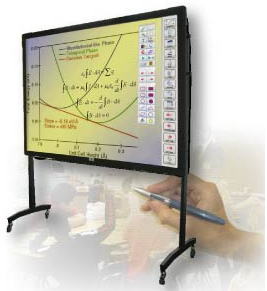The previous article in this series demystified some of the operational
issues.
1. Consider Brightness Levels when Buying Interactive
Whiteboard Projectors
1500 lumens is the standard brightness level for use with classroom
projectors as recommended by BECTA. Avoid projectors with anything over 1500
lumens because these have been associated with health and safety fears wherever
they are used. Additionally, avoid looking directly or passing through the
light beam when using the projector. To further reduce the intensity of the
light, use the whiteboard’s off-white background color.
2. Health and Safety Issues
Always keep cables in a trunk or conduit and keep them away from walkways
to prevent people from tripping and wearing out the cables. Always be on the
lookout for protruding marker trays on the whiteboard that can scrape and
injure passers-by.
While wheeled-stands can be another perfect way to move the interactive
whiteboard around, they are another prime source for incidents of
tripping.
3. The Right Height for Placing the Interactive
Whiteboard
When positioning the interactive whiteboard, it is always important to
consider the height and age of the teachers and students who will be using the
board and the applications that will be used. Some applications will need to be
initiated by the teacher while others would need to be accessed from the top of
the whiteboard. In such a case, the whiteboard will need to be placed within
the reach of every student and teacher.
Some of the newer pieces of equipment come with height adjustable stands
such as the IntechBoard Mobile Stand that allows the whiteboard’s height to be
adjusted along the stand’s length. Other solutions such as wall-mounted systems
with height-adjustability and platforms for younger children can be used to
ensure everyone has access to the interactive whiteboard.
4. Calibrating the Interactive Whiteboard
When the interactive whiteboard and related peripheral devices are
installed, they are normally calibrated to work with the environment they have
been installed in. When any major piece of equipment such as the interactive
whiteboard or projector is moved, you will have to recalibrate the system,
though newer systems can automatically calibrate themselves.
You will also need to update the settings on your laptop or PC in case the
display from your computer to the whiteboard is faulty. Most laptops are now
running native 1280 x 800 resolutions (16:9 aspect ratios) while most
entry-level projectors still run native 1024 x 768 resolutions.
One of the best ways to ensure your content is correctly displayed on the
interactive whiteboard is to use the laptop’s “Multiple Display” function to
extend your desktop to the interactive whiteboard. To enable this function,
head over to “Control Panel” on your laptop, click on “Screen Resolution” under
“Appearance and Resolution” and select 1024 x 768 in the drop down menu under
“Resolution.” Click “Apply” and you will be on your way to enjoying the
complete interactive experience straight from your laptop.
Previous:Touch Screen Technologies for Interactive Whiteboards and Other Electronic Devices
Next:Tips and Best Practices for Using an Interactive Whiteboard: Part One

